I’ve been putting miles on the 1974 RD350 in the last few months, almost doubling the 4100 miles that showed on the bike’s odometer when I first got it. As my confidence in the bike increases so do the miles racked up in a single ride. This increase in running time has led to a problem with the battery that was installed in the RD350.
The battery seemed to work okay; it held a charge and didn’t use too much electrolyte but the fill plugs located on top were seeping a bit of acid. The caps felt snug and the battery vent was not clogged yet after a long ride the acid-damp lay heavy on the battery and even started dripping down the sides. I sort of let it slide for a while. Riding the RD is too much fun and stopping the bike for maintenance seemed like a waste of good weather.
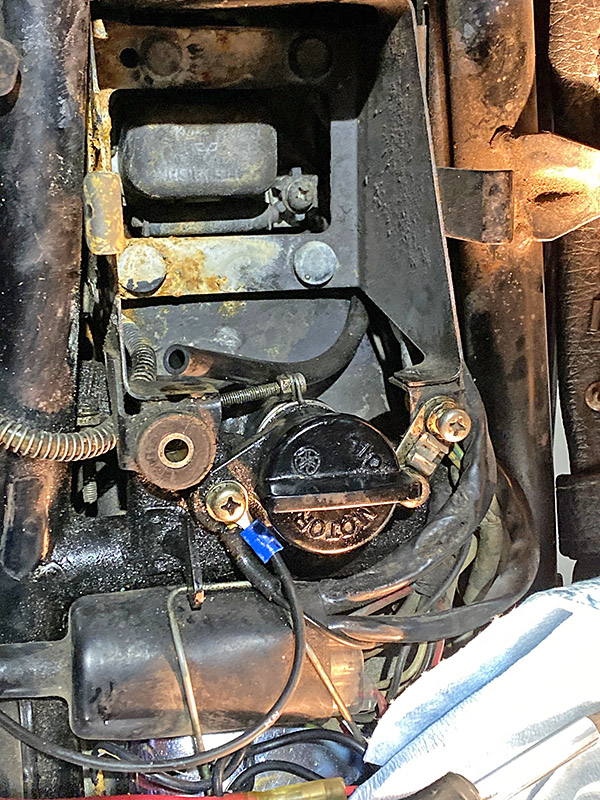
Now that it’s a bit cooler I tackled the battery situation. The acid had dripped down onto the swing arm and corroded the battery box along with the small coil spring that keeps the oil tank vent from kinking. My laziness always comes back to haunt me.
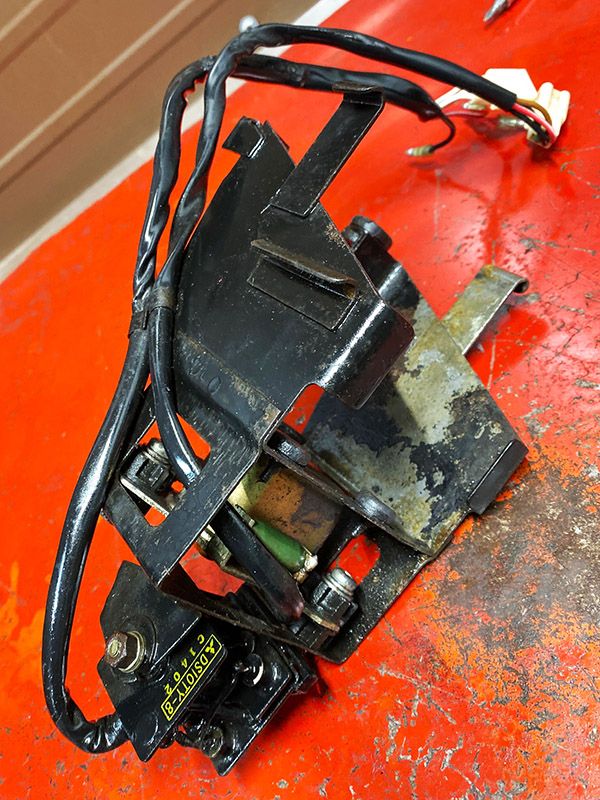
I took the battery box, along with the attached rectifier and voltage regulator out of the frame and washed everything down with a mix of baking soda and water. The affected paint fell off in large chunks. I dismantled the electrical components and soaked the battery box in Evap-Rust then wire brushed any loose paint.
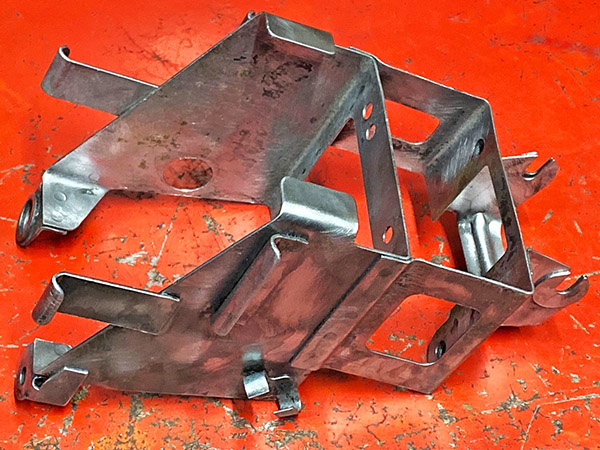
It was a nippy week at The Ranch so painting the box in 50-degree weather was a challenge. I heated the rattle can and the battery box to within 2.8 degrees of each other (measured via a recently calibrated fingertip) then shot the box with primer and two coats of Krylon satin black. I used a brush to apply paint to the bare spots on the swing arm.

It all came out good enough and anyway, I’m riding this bike, not showing it. The electrical bits, being directly under the battery did not suffer any acid corrosion. I cleaned them up and reassembled the mess into the motorcycle.
Many older motorcycles do not regulate their voltage as precisely as you would like and my Yamaha RD350 is one of the many. With the headlights on and engine revving I measured 14/14.1 volts at the battery. This is ideal. With the headlights off 15 volts were going into the battery. 15 volts is a little too high for comfort but I decided that since I leave the headlights on all the time the original regulator would be okay.
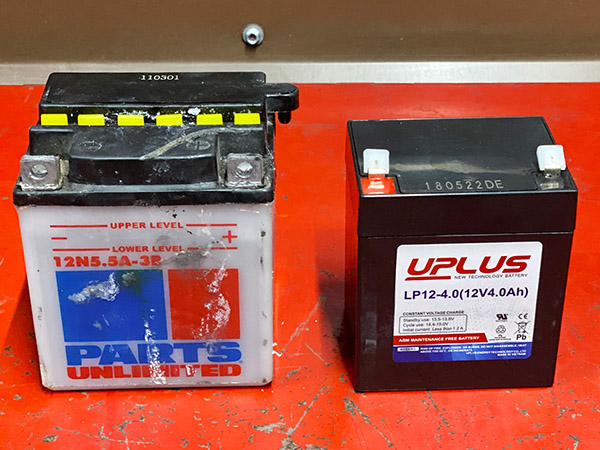
My good buddy Deet told me about using sealed, AGM type, alarm-system/UPS batteries in old bikes. I have had one of them in Godzilla, the 1971 RT1-B for a couple years and it has been working great. These type batteries hold a charge much longer than flooded lead acid batteries. The new one I bought on Amazon has a high tolerance for high voltage; it can handle up to 15-volts charging. These AGM standby batteries can withstand constant trickle charging and long periods of inactivity, which describes vintage motorcycle riding to a tee. The small spade terminals on these batteries are not made for large current loads like an electric starter or lighting up the strip in Las Vegas but they can handle motorcycle lighting and ignition circuits without complaint.
At 4AH the new battery has a bit less capacity than the leaky old 5.5AH unit I took out but I think it will work okay. Close enough counts in hand grenades, horseshoes and motorcycle batteries.
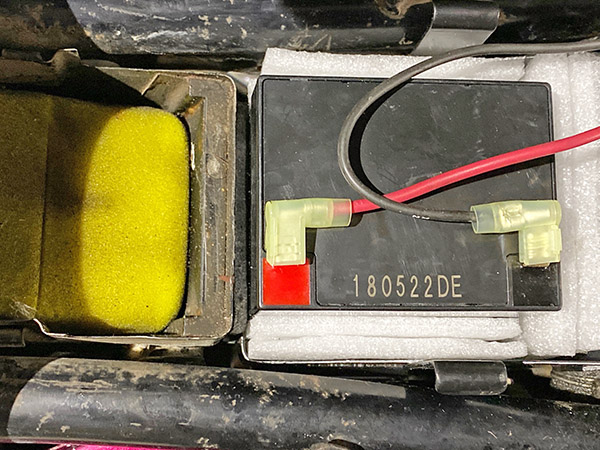
The new battery is a skosh smaller than the old battery so I used some closed-cell packing foam to keep the thing from rattling around inside the battery box. The RD350 is once again ready to rumble. From my experience with the RT1-B, I’m not anticipating any problems with the RD350 but I’ll be sure to let ExhaustNotes readers know if I have any issues with the new AGM set up.
Do a friend a favor or ten: Click on those popup ads!
Never miss an ExNotes blog:


Joe! Great garage job on the gleaning and painting of the box.
I should have kept a 350 yam but didn’t think I was going to get to be as old and somewhat broken down as I am these days . Now that I trend for smaller and lighter bikes. Oh well.
On the battery . Well yea. Chopper Brit bike types have been promoting wheel chair battery’s for years. But now that agm bats come moto specific that’s the way I would go.
My question is amp hours. My old bsa chopper battery was for Harley sportsters. It was lead acid but I THINK 8amps. I could go out for an afternoon with a dead alternator and if I got back by dark I was fine.
Ran it that way for the season until replacing everything that next winter.
My point is with an old bike , especially off in the distant rides you take , a bit more amps then 4 would make me feel a bit more secure.
I did enjoy this blog entry! Thanks for sharing it
Oh. I HATE riding with the headlite on. I don’t know how many times I got the feeling on coming traffic think I am a “Popeye “ . (Cage with one headlight out)
I am a true believer of target fixation And tend to shy from those bright klown puke green “safety “ apparel as well.
But to me riding around in broad daylight with lights on is akin to the proverbial “dont know enuff to come in out of the rain”. Not to mention headlite is on but nobody is home . (False sense of security)
Now my electric start bikes all have headlite on when starting! It’s a real drag on my 85 R65 .
I have a cutout switch for my 2012 Bonneville but never figured how to install. From what I understand triumphs now come with the headlite off at least to start .
I have bat tender jr wires splayed out all over my garage. Lol. I will tidy that up . Someday !
Hack,
Headlight on is much more noticeable. I think it may be a bit safer. Car drivers are so distracted today that any slight advantage in visibility is a good thing.
For a kickstart bike I think the 4 amps will be ok. just don’t leave your ignition and headlights on with the bike not running. On long trips I bring a jump starter just in case.
That battery box is in great condition. I’d have clear coated it. Make sure you ride with your headlight on. It’s best to be mistaken for a popeye than nothing at all. Anyways, car drivers give wide berths to popeyes not knowing if they’re a left or right popeye. It’s true.
Use a lithium back up 6v battery in my Honda S90. Has worked great for years. Bought for $6.50 on line plus shipping. Bike doesn’t get a lot of miles by the neutral light always shines bright. I use a $1.98 rectifier I built from Radio Shack components.
“…I heated the rattle can and the battery box to within 2.8 degrees of each other (measured via a recently calibrated fingertip) then shot the box with primer and…”
Did anyone else feel a bit panicked at this point, or no?
I was waiting for the rubble to be cleared and bodies to be identified. ATF dogs to be sniffing about and so on…